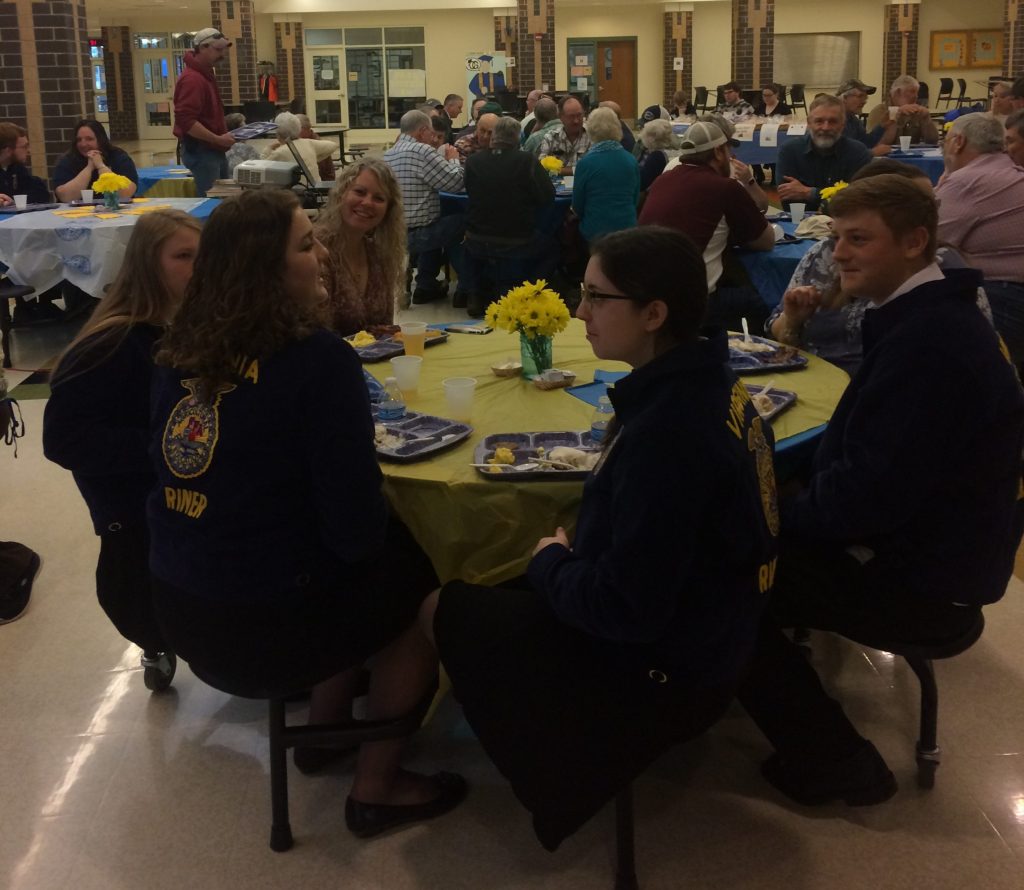
On a cold spring morning at Auburn High School, people in Carhartt work wear, tidy blouses and camouflage caps were holding the doors for each other and calling greeting as they stream into Auburn High School’s front office amid corn-yellow and true-blue balloons that said “Future Farmers of America.”
FFA is the national youth organization that develops leadership and personal growth through agricultural education.
Here at AHS, as they have for a quarter century, the FFA and ag-education hosted around 50 local farmers for breakfast and conversation early on National Agriculture Day morning
At a time when the average age of the American farmer is 58 –– long-in-the-tooth in this physically demanding and risk-filled job, the nation is working to encourage and train new farmers.
Breakfasts like this one, work to connect beginning farmers with established local farmers, helping transfer hard-won traditional skills and knowledge in Auburn’s cafeteria this morning to the next generation by combining tradition with a new dynamic diversity.
Welcoming their guests at tables ornamented with vases of yellow chrysanthemums they’ve arranged, FFA club members are embracing agriculture by developing work-ready skills in ag-related fields working in horticulture, dairy farms and veterinary medicine.
Kim Smith, curly blonde and in a pretty dress, is the ag-ed teacher and FFA club advisor, works with young people to learn about this multi-disciplinary industry that’s changing even as she’s teaching it.
“Well, it’s certainly never boring, “ Smith said, laughing.
Raised in Lovettsville, Smith said she’s seen change first hand as the prime farmland, landscape and lifestyle of Northern Virginia agriculture was lost to development, but reinvented itself as it gained access to bustling metropolitan markets.
But because of the expense of land, hard labor and the gambles of food and fiber production, even in rural Montgomery County, few young people will actually become farmers.
“In this area it’s higher, we’re such a farming community, but still, it’s about
30 percent,” she said. “A lot of young people don’t want to take ag on as a full-time job because it’s so risky. These kids will have some farming on the side. And you see ag moving more that way, because people want to make a good living for their families. But, unless you’re born into a situation where you’re born into a lot of land, it’s a difficult industry to get into.”
Agriculture is changing because of outside pressure, and inside pressures too. When Smith started teaching thirteen years ago, fewer women were in FFA, but that’s changed.
“You used to see the curriculum was shop, woodworking, welding, and farming. Now there’s greater variety in agriculture. ”She teaches woodworking and welding, but also animal care and vet science and horticulture and floral design and kids work in vet offices. “When you see those areas in play, you see more women,” Smith said.
Farming on the edge of cities and towns is a double-edged sword. Rural Montgomery County may suffer from increased land costs and loss of ag infrastructure, but benefit from easier access to markets and restaurants Smith said.
“A lot of Local farmers cater to those and others play into big-time, commodities.
We have one of the biggest pumpkin farms. The King Family. They sell to Wal-Mart. Pumpkins, are huge and dairy and beef cattle are still huge in Montgomery County Those are primary commodities.”
The realities of American agriculture are so policy- and legislation-driven, Smith teaches young people about the importance of participating in understanding and driving that policy to raise broader awareness and respect for agriculture.
“I think it’s important for our students to understand not only as citizens, but as consumers, that they have the most power because, in any industry, if there’s demand, someone will supply that demand. If they want to support, for example, organic systems, or local ag, they have to support that at the grocery store. They need to support that when they purchase. I also teach USDA and FDA do a great job.”
Not everybody’s a farmer, but everybody eats, and as the landscape shifts beneath its feet, American agriculture struggles through complicated conversations about global trade, the value of small-scale agriculture, efficiencies of scale, environmental and water protection, and cheap, safe food.
“I think, “ Smith said, “regardless of whether people are going into ag, as a career they need to be informed about it,” Smith said, “because everybody needs food and fiber. Purchasing decisions and supporting legislation are the two ways we can support it, even if they are not directly farming.”




